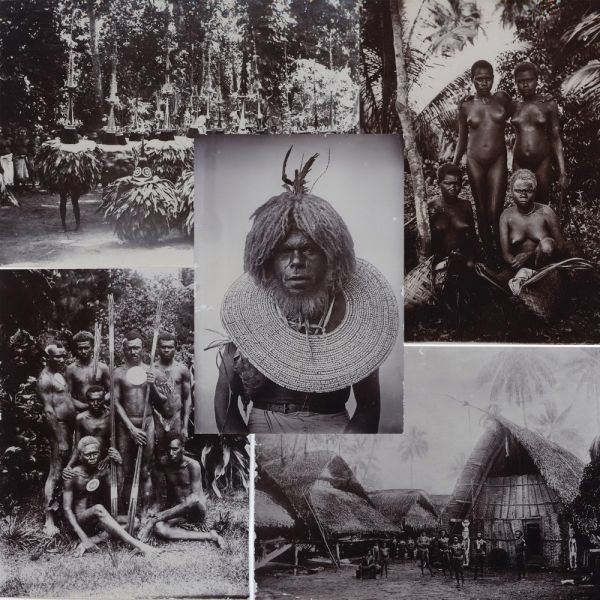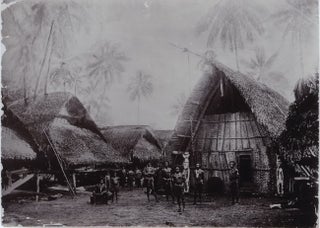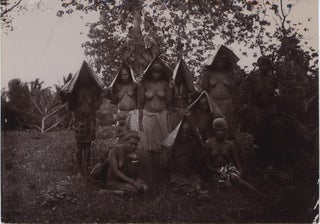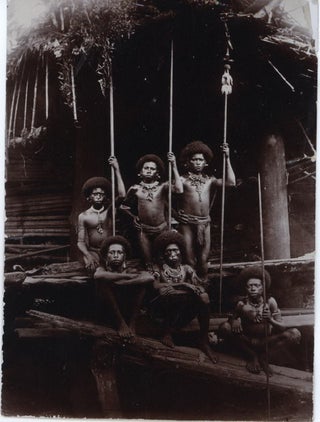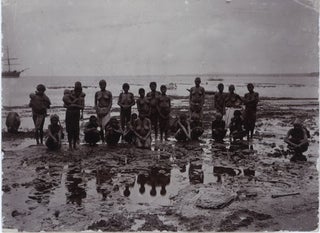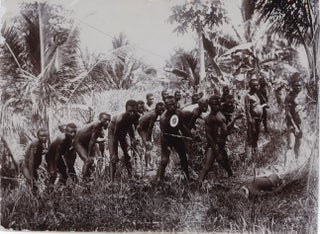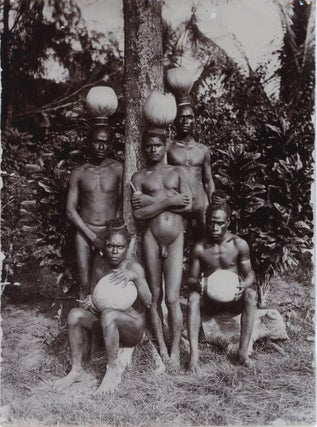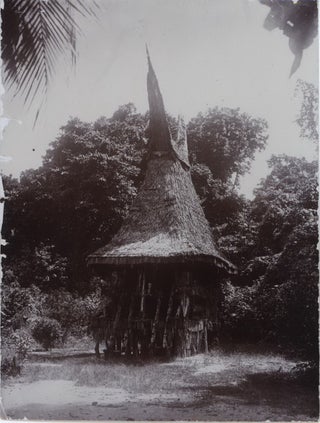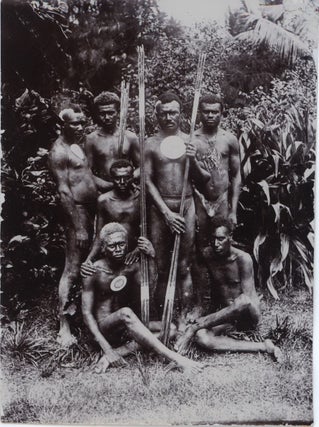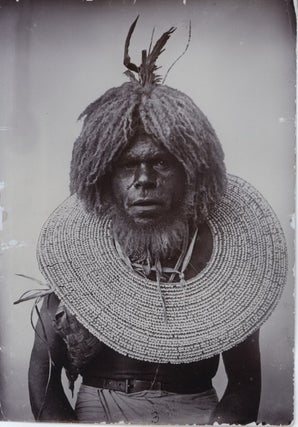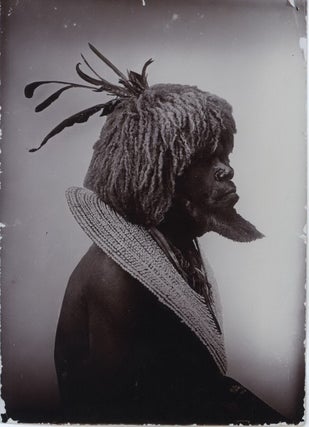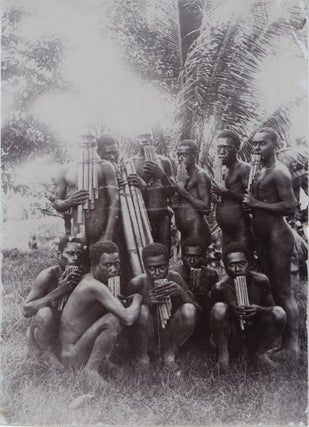Forty-four vintage photographs (circa 1887-94) of indigenous life in the Bismarck Archipelago and German New Guinea are offered as a collection
All photographs are archivally mounted and unframed; the size of each image is approximately 150 × 205 mm or the reverse. The condition is uniformly excellent. A separate illustrated catalogue has been prepared and is available on request.
Richard Parkinson (1844-1909) is usually considered to have been of German origin, although he was born in the Duchy of Schleswig when it was part of Denmark. Following Germany's establishment of its Pacific Island colonies in the late nineteenth century, Parkinson was officially recognized by the colonial authorities as being German. He arrived in Samoa in 1876, having been employed by the German trading and plantation company Godeffroy as a surveyor and plantation manager. He became involved in the local political and social scenes and in 1879 married sixteen-year-old Phebe Coe, sister of Emma Coe, the American-Samoan who later became famous as Queen Emma of the South Seas. Emma moved to the Duke of York Islands, between New Britain and New Ireland in the Bismarck Archipelago, in 1879 to recruit labour and to trade throughout the islands. Trade supplies were neither reliable nor regular, so she decided to establish her own plantations. Parkinson resigned from Godeffroy around 1880-81 and in late 1882 he accepted Emma's invitation to work for her. She gave him the responsibility of setting up the first of her plantations on the mainland of New Britain. He selected an area at Ralum on the coast of the Gazelle Peninsula, on the south side of Blanche Bay, and set up the first coconut plantation in the New Guinea area. In 1890, Parkinson had a disagreement with Emma about the amount of time he spent collecting natural history specimens and on ethnological studies instead of concentrating on his plantation work. He then commenced work as a collector and surveyor for the Deutsch Neu Guinea Compagnie, which managed the colony on behalf of the German Government after the Bismarck Archipelago was declared a protectorate in November 1884. His work with the company provided him with many opportunities to travel and collect artefacts and information in the region. He may never have been the first contact of any local people, but he was clearly among the first; indeed, the small European community in the Duke of York Islands and on New Britain increased slowly from around 30 in 1883 to only 112 in 1894. He observed many societies before they were extensively incorporated into the Western economy or influenced by missionaries. A keen and intelligent observer, Parkinson was self-taught, without anthropological training, but he thought it worthwhile to make a record, no matter how fragmentary and incomplete it was. His first book, 'Im Bismarck-Archipel' (1887), contained by way of illustrations, only amateurish drawings and lithographs. Subsequently, he acquired skills in photography and collaborated with A.B. Meyer to produce a magnificent two-volume 'Album von Papua-Typen' (1894, 1900), comprising images of people and scenes of the New Guinea and Bismarck Archipelago region. The first edition of his most enduring work, 'Dreissig Jahre in der Südsee' (1907), contains 197 illustrations, of which approximately half are reproductions of his images of people and scenes. His photographs remained a major source of visual information long after his death and they retain their importance to this day. Meyer's preface to the second volume of 'Album von Papua-Typen', published in 1900, refers to the 1894 volume thus: 'being out of print and a second edition of the same standards being impracticable on account of the destruction of the negatives, Mr Parkinson ... has ... prepared a new series of views and again placed the negatives at my disposal'. Of the present collection, none appear in Parkinson's 1887 and 1900 publications, and less than a handful appear in his major work of 1907. Approximately 20 of the 54 images in the very rare 1894 album are reproductions of around 25 photographs in this collection. In the translation to his foreword to 'Dreissing Jahre in der Südsee' Parkinson states that the plates contribute much to the illustration of the contents. Those who desire further pictorial material will find this in the two-volume set of albums. The range of images in this collection provides a rich and varied cross-section of indigenous life and practices of the time. There are many scenes of daily village life, both inland and on the coast, with fine views of substantial (as well as rudimentary) huts, canoes, gigantic fish baskets, ceremonial grounds, men fishing with nets ... There are numerous group portraits, almost all of them on a different theme (men, women, young, old, some naked, others richly adorned, sheltering from the rain, or armed with musical instruments or spears or bows and arrows; there are two staged battle scenes, one complete with a spear-riddled body). There are five matching pairs of individual portraits - front-view and profile - again with each of them having something different to add to the overall depth of the collection. Not least, there are four photographs featuring the Dukduk, the secret society already in decline when Parkinson was active in the area. Between 1882 and 1909 Parkinson, his wife, her sister Emma and their circle sold or donated vast quantities of artefacts to museums in Australia, the USA and Germany; the precise quantity is unknown, but it is believed to exceed 10,000 items. Documentation presumably included photographs (presumably still held by those institutions). His images were also available commercially at the time, in the period immediately prior to the introduction of the picture postcard; some of the present collection have the ink stamp of Robert Lenz and Co., Singapore on the verso. However, vintage Parkinson prints are undeniably rare on the open market, and Meyer's comment in 1900 regarding the earlier destruction of the negatives of images appearing in the 1894 publication indicates why later prints of his important earlier work have not surfaced.
Item #75896
Price (AUD):
$135,000.00

